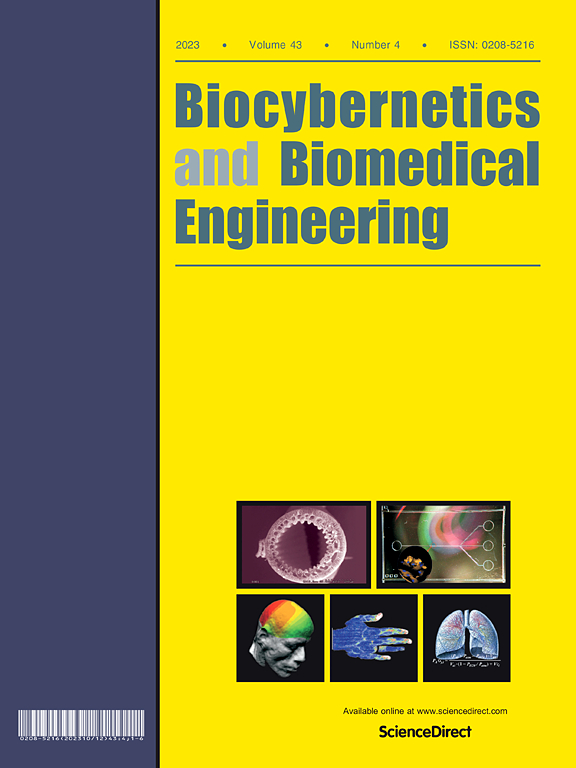Multi-scale CNN-Swin transformer network with boundary supervision for multiclass biomarker segmentation in retinal OCT images
IF 6.6
2区 医学
Q1 ENGINEERING, BIOMEDICAL
引用次数: 0
Abstract
Retinal biomarker morphology is closely associated with a variety of chronic ophthalmic diseases, in which biomarker localization and segmentation in optical coherence tomography (OCT) play a key role in the diagnosis of retina-related diseases. Although great progress has been made in deep learning based OCT biomarker segmentation, several challenges still exist. Due to issues such as image noise or class imbalance, retinal biomarkers affect the model’s recognition of other biomarkers. Moreover, small biomarkers are prone to lose accuracy during downsampling. And most existing methods rely on convolutional neural networks, which make it challenging to obtain the global context due to locality of convolution. Benefiting from the Swin Transformer with powerful modeling capabilities, we propose MSCS-Net (Multi-scale CNN-Swin Network), a network for OCT biomarker segmentation, which effectively combines CNN and Swin Transformer and integrates them in parallel into a dual-encoder structure. Specifically, an edge detection path is added alongside to enhance the localization of biomarkers at the edges. For the Swin Transformer branch, considering the irregular distribution of most OCT biomarkers, a new windowing partition is performed in the Swin Transformer to capture the features more efficiently. Meanwhile, we design a Feature Dimensionality Reduction Module to extensively collect the information of small-scale biomarkers. To effectively integrate information from two scales, we design a Transformer Cross Fusion Module to finely fuse the global and local feature information from the two-branch encoders. We validate the proposed approach on local and public datasets, and the experimental results demonstrate the effectiveness of the proposed framework.
基于边界监督的多尺度CNN-Swin变压器网络用于视网膜OCT图像中多类别生物标记物分割
视网膜生物标志物形态与多种慢性眼科疾病密切相关,光学相干断层扫描(OCT)中生物标志物的定位和分割在视网膜相关疾病的诊断中起着关键作用。尽管基于深度学习的OCT生物标记物分割已经取得了很大的进展,但仍然存在一些挑战。由于图像噪声或类别不平衡等问题,视网膜生物标记物会影响模型对其他生物标记物的识别。此外,小生物标记物在下采样过程中容易失去准确性。现有的方法大多依赖于卷积神经网络,由于卷积的局部性,难以获得全局上下文。利用Swin Transformer强大的建模能力,我们提出了一种OCT生物标记物分割网络MSCS-Net (Multi-scale CNN-Swin Network),该网络将CNN和Swin Transformer有效地结合在一起,并将它们并行集成到一个双编码器结构中。具体来说,在边缘检测路径旁边添加了一个边缘检测路径来增强生物标记物在边缘的定位。对于Swin Transformer分支,考虑到大多数OCT生物标志物的不规则分布,在Swin Transformer中进行了新的窗口划分,以更有效地捕获特征。同时,我们设计了一个特征降维模块,广泛收集小尺度生物标志物的信息。为了有效地整合两个尺度上的信息,我们设计了一个变压器交叉融合模块来精细地融合来自两支路编码器的全局和局部特征信息。我们在本地和公共数据集上验证了所提出的方法,实验结果证明了所提出框架的有效性。
本文章由计算机程序翻译,如有差异,请以英文原文为准。
求助全文
约1分钟内获得全文
求助全文
来源期刊

Biocybernetics and Biomedical Engineering
ENGINEERING, BIOMEDICAL-
CiteScore
16.50
自引率
6.20%
发文量
77
审稿时长
38 days
期刊介绍:
Biocybernetics and Biomedical Engineering is a quarterly journal, founded in 1981, devoted to publishing the results of original, innovative and creative research investigations in the field of Biocybernetics and biomedical engineering, which bridges mathematical, physical, chemical and engineering methods and technology to analyse physiological processes in living organisms as well as to develop methods, devices and systems used in biology and medicine, mainly in medical diagnosis, monitoring systems and therapy. The Journal''s mission is to advance scientific discovery into new or improved standards of care, and promotion a wide-ranging exchange between science and its application to humans.
 求助内容:
求助内容: 应助结果提醒方式:
应助结果提醒方式:


